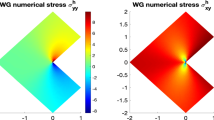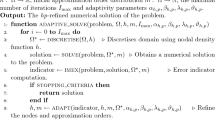Abstract
Higher-order polygonal finite elements are developed for adaptive analyses of linear elastic problem. These elements are constructed using virtual node method based on partition of unity coupled with polynomial enrichment functions. Because the element shape functions are polynomials, the stiffness matrix is computed precisely with standard Gauss quadrature rules. Several numerical examples of linear elasticity are presented to validate the accuracy and convergence of the proposed elements. One of the advantages of the proposed elements is that they can be used as transition elements with hanging nodes on higher-order approximation meshes. Building on this advantage, h- and hp-adaptive finite element analyses of numerical examples with local singularities are performed on triangular quadtree meshes in order to demonstrate the performance of the adaptive strategies using the proposed elements.
Similar content being viewed by others
References
S. Moorthy and S. Ghosh, Adaptivity and convergence in the Voronoi cell finite element model for analyzing heterogeneous materials, Computer Methods in Applied Mechanics and Engineering, 185 (1) (2000) 37–74.
S. Biabanaki and A. Khoei, A polygonal finite element method for modeling arbitrary interfaces in large deformation problems, Computational Mechanics, 50 (1) (2012) 19–33.
C. Talischi, G. Paulino and C. Le, Honeycomb Wachspress finite elements for structural topology optimization, Structural and Multidisciplinary Optimization, 37 (6) (2009) 569–583.
J. F. Peters and E. Heymsfield, Application of the 2-D constant strain assumption to FEM elements consisting of an arbitrary number of nodes, International Journal of Solids and Structures, 40 (1) (2003) 143–159.
A. Tabarraei and N. Sukumar, Adaptive computations on conforming quadtree meshes, Finite Elements in Analysis and Design, 41 (7) (2005) 686–702.
E. L. Wachspress, A rational finite element basis, Elsevier, New York (1975).
M. S. Floater, Mean value coordinates, Computer Aided Geometric Design, 20 (1) (2003) 19–27.
N. Sukumar and A. Tabarraei, Conforming polygonal finite elements, International Journal for Numerical Methods in Engineering, 61 (12) (2004) 2045–2066.
S. Natarajan, S. Bordas and D. Roy Mahapatra, Numerical integration over arbitrary polygonal domains based on Schwarz–Christoffel conformal mapping, International Journal for Numerical Methods in Engineering, 80 (1) (2009) 103–134.
S. Mousavi, H. Xiao and N. Sukumar, Generalized Gaussian quadrature rules on arbitrary polygons, International Journal for Numerical Methods in Engineering, 82 (1) (2010) 99–113.
M. Rashid and P. Gullett, On a finite element method with variable element topology, Computer Methods in Applied Mechanics and Engineering, 190 (11) (2000) 1509–1527.
K. Dai, G. Liu and T. Nguyen, An n-sided polygonal smoothed finite element method (nSFEM) for solid mechanics, Finite Elements in Analysis and Design, 43 (11) (2007) 847–860.
X.-h. Tang, S.-C. Wu, C. Zheng and J.-h. Zhang, A novel virtual node method for polygonal elements, Applied Mathematics and Mechanics, 30 (10) (2009) 1233–1246.
I. Babuška and W. C. Rheinboldt, A-posteriori error estimates for the finite element method, International Journal for Numerical Methods in Engineering, 12 (10) (1978) 1597–1615.
O. C. Zienkiewicz and J. Z. Zhu, A simple error estimator and adaptive procedure for practical engineerng analysis, International Journal for Numerical Methods in Engineering, 24 (2) (1987) 337–357.
K. C. Chellamuthu and N. Ida, Algorithms and data structures for 2D and 3D adaptive finite element mesh refinement, Finite Elements in Analysis and Design, 17 (3) (1994) 205–229.
P. Krysl, E. Grinspun and P. Schröder, Natural hierarchical refinement for finite element methods, International Journal for Numerical Methods in Engineering, 56 (8) (2003) 1109–1124.
S. Wille, A structured tri-tree search method for generation of optimal unstructured finite element grids in two and three dimensions, International Journal for Numerical Methods in Fluids, 14 (7) (1992) 861–881.
A. Gupta, A finite element for transition from a fine to a coarse grid, International Journal for Numerical Methods in Engineering, 12 (1) (1978) 35–45.
Y.-S. Cho and S. Im, MLS-based variable-node elements compatible with quadratic interpolation. Part I: formulation and application for non-matching meshes, International Journal for Numerical Methods in Engineering, 65 (4) (2006) 494–516.
L. Demkowicz, Computing with hp-ADAPTIVE FINITE ELEMENTS: Volume 1 One and Two Dimensional Elliptic and Maxwell problems, Chapman & Hall/CRC, Boca Raton (2006).
N. Sukumar, Quadratic maximum-entropy serendipity shape functions for arbitrary planar polygons, Computer Methods in Applied Mechanics and Engineering, 263 (2013) 27–41.
A. Rand, A. Gillette and C. Bajaj, Quadratic serendipity finite elements on polygons using generalized barycentric coordinates, Mathematics of Computation, 83 (2014) 2691–2716.
S. Wu, X. Peng, W. Zhang and S. Bordas, The virtual node polygonal element method for nonlinear thermal analysis with application to hybrid laser welding, International Journal of Heat and Mass Transfer, 67 (2013) 1247–1254.
J. Oden, C. Duarte and O. Zienkiewicz, A new cloud-based hp finite element method, Computer Methods in Applied Mechanics and Engineering, 153 (1) (1998) 117–126.
I. Babuska and J. M. Melenk, The partition of unity finite element method, International Journal for Numerical Methods in Engineering, 40 (4) (1997) 727–758.
C. Duarte, I. Babuška and J. Oden, Generalized finite element methods for three-dimensional structural mechanics problems, Computers & Structures, 77 (2) (2000) 215–232.
R. E. Bank, A. H. Sherman and A. Weiser, Some refinement algorithms and data structures for regular local mesh refinement, Scientific Computing, Applications of Mathematics and Computing to the Physical Sciences, 1 (1983) 3–17.
Z. Shi and X. Zhao, Error reduction of the adaptive conforming and nonconforming finite element methods with red–green refinement, Numerische Mathematik, 123 (3) (2013) 553–584.
L. Demkowicz, J. T. Oden, W. Rachowicz and O. Hardy, Toward a universal h-p adaptive finite element strategy, part 1. Constrained approximation and data structure, Computer Methods in Applied Mechanics and Engineering, 77 (1-2) (1989) 79–112.
P. Hansbo, C. Lovadina, I. Perugia and G. Sangalli, A Lagrange multiplier method for the finite element solution of elliptic interface problems using non-matching meshes, Numerische Mathematik, 100 (1) (2005) 91–115.
L.-y. Li and P. Bettess, Adaptive finite element methods: a review, Applied Mechanics Reviews, 50 (10) (1997) 581–591.
W. Bangerth and R. Rannacher, Adaptive Finite Element Methods for Differential Equations, Springer (2003).
L. Demkowicz, W. Rachowicz and P. Devloo, A fully automatic hp-adaptivity, Journal of Scientific Computing, 17 (1-4) (2002) 117–142.
E. Siili, P. Houston and C. Schwab, hp-Finite element methods for hyperbolic problems, The Mathematics of Finite Elements and Applications X. MAFELAP (1999) 143–162.
A. Byfut and A. Schröder, hp-adaptive extended finite element method, International Journal for Numerical Methods in Engineering, 89 (11) (2012) 1392–1418.
S. T. Babuška, I. K. Copps, S. K. Gangaraj and C. S. Upadhyay, A-posteriori error estimation for finite element and generalized finite element method, The University of Texas at Austin (1998).
C. Talischi, G. H. Paulino, A. Pereira and I. F. Menezes, PolyMesher: a general-purpose mesh generator for polygonal elements written in Matlab, Structural and Multidisciplinary Optimization, 45 (3) (2012) 309–328.
S. Timoshenko, Theory of elasticity, McGraw-Hill, New York (1987).
M. Meyer, A. Barr, H. Lee and M. Desbrun, Generalized barycentric coordinates on irregular polygons, Journal of Graphics Tools, 7 (1) (2002) 13–22.
N. Sukumar and E. A. Malsch, Recent advances in the construction of polygonal finite element interpolants, Archives of Computational Methods in Engineering, 13 (1) (2006) 129–163.
A. Tabarraei and N. Sukumar, Application of polygonal finite elements in linear elasticity, International Journal of Computational Methods, 3 (4) (2006) 503–520.
B. A. Szabo and I. Babuška, Finite element analysis, John Wiley & Sons, New York (1991).
F. B. Barros, S. P. B. Proença and C. S. de Barcellos, On error estimator and p-adaptivity in the generalized finite element method, International Journal for Numerical Methods in Engineering, 60 (14) (2004) 2373–2398.
Author information
Authors and Affiliations
Corresponding author
Additional information
Recommended by Associate Editor Gang-Won Jang
Byung Chai Lee received B.S. degree (1977) of mechanical engineering from Seoul National University, Korea and Ph. D. (1984) of mechanical engineering from Korea Advanced Institute of Science and Technology (KAIST), Korea. He is currently a professor at the department of mechanical engineering in KAIST. His areas of interest are finite element method and structural optimization.
Rights and permissions
About this article
Cite this article
Oh, H.C., Lee, B.C. hp-adaptive finite element method for linear elasticity using higher-order virtual node method. J Mech Sci Technol 29, 4299–4312 (2015). https://doi.org/10.1007/s12206-015-0927-y
Received:
Revised:
Accepted:
Published:
Issue Date:
DOI: https://doi.org/10.1007/s12206-015-0927-y




